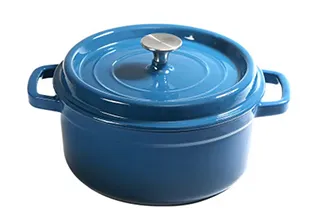
fry egg cast iron
The Art of Frying Eggs in a Cast Iron Skillet
Frying an egg might seem like a simple task, but when done properly, it can transform into a culinary art form, especially when using a cast iron skillet. Cast iron cooking equipment has stood the test of time, maintaining its popularity for its superior heat retention and even cooking properties. Whether you prefer your eggs sunny-side up, over-easy, or scrambled, mastering the technique of frying eggs in cast iron can elevate your breakfast game significantly.
The Beauty of Cast Iron
Cast iron skillets are revered for their durability and versatility. These heavy-duty pans can withstand high temperatures and can be used on the stovetop, in the oven, or even over an open flame. Their ability to maintain consistent heat makes them ideal for frying eggs. Unlike non-stick pans, cast iron skillets develop a natural non-stick surface when seasoned correctly, which allows for easy cooking and cleanup.
Seasoning Your Skillet
Before frying your perfect egg, it’s crucial to ensure your cast iron skillet is well-seasoned. Seasoning is a process where a thin layer of oil is baked onto the skillet, creating a non-stick surface. To season your skillet, follow these steps
1. Clean Start with a clean, dry skillet. If your skillet is new or hasn’t been used for a while, wash it with a bit of soap and water, then dry it completely. 2. Oil Apply a thin layer of vegetable oil or flaxseed oil over the surface of the skillet. 3. Bake Place the skillet upside down in an oven preheated to 375°F (190°C) for an hour. This allows the oil to polymerize, creating a durable non-stick layer. 4. Cool Let the skillet cool inside the oven before removing it.
After seasoning, your skillet will be ready to use for frying eggs and can be used for an array of other cooking techniques.
The Perfect Fried Egg
Here’s a step-by-step guide to frying the perfect egg in a cast iron skillet
fry egg cast iron

1. Preheat Place your cast iron skillet on medium heat and let it heat up for a few minutes. To test if it’s hot enough, sprinkle a few drops of water onto the skillet. If they dance and evaporate quickly, it’s time to add oil.
2. Add Oil Pour a teaspoon of oil (vegetable, olive, or butter) into the skillet. Swirl the oil around to coat the bottom evenly. The oil should shimmer but not smoke.
3. Crack the Egg Carefully crack your egg into a small bowl first, then gently slide it into the skillet. This helps prevent shell pieces from getting into your dish and allows for a cleaner pour.
4. Cook Let the egg cook undisturbed. For sunny-side up, cook until the whites are completely set while the yolk remains runny. For over-easy, gently flip the egg after a few minutes and cook for an additional minute.
5. Seasoning Season your egg with a pinch of salt and fresh pepper to enhance the flavor.
6. Serve Use a spatula to gently lift the egg from the skillet and transfer it to a plate. Serve it on toast, with avocado, or alongside bacon for a delightful breakfast.
Cleaning Your Skillet
After enjoying your meal, cleaning your cast iron skillet is straightforward. Avoid soap as it can strip the seasoning. Instead, simply scrub the skillet with hot water and a stiff brush. For stubborn bits, use coarse salt as an abrasive. Dry the skillet immediately and apply a thin layer of oil to maintain its seasoning.
Conclusion
Frying eggs in a cast iron skillet is not only practical but also an enjoyable experience that can enhance your cooking skills. With proper seasoning and techniques, you can create perfectly fried eggs that are sure to impress. So, dust off that cast iron skillet and get ready to enjoy the timeless tradition of frying eggs to perfection!
-
High Quality Kitchen Durable Black Round Cast Iron Cookware Pancake Crepe Pan-Baixiang County Zhongda Machinery Manufacturing Co., Ltd.|Durability,Non-Stick SurfaceNewsJul.22,2025
-
High Quality Cast Iron Cookware-Pan with Wooden Handle|Durable,Non-Stick,Even Heat DistributionNewsJul.21,2025
-
Cast Iron Pancake Crepe Pan-Durable Kitchenware|Non-Stick&Wooden HandleNewsJul.21,2025
-
Cast Iron Pancake Crepe Pan-Durable Kitchenware|Non-Stick&Wooden HandleNewsJul.21,2025
-
Cast Iron Pancake Crepe Pan-Durable Kitchenware|Non-Stick&Wooden HandleNewsJul.21,2025
-
Cast Iron Pancake Crepe Pan-Durable Kitchenware|Non-Stick&Wooden HandleNewsJul.21,2025


